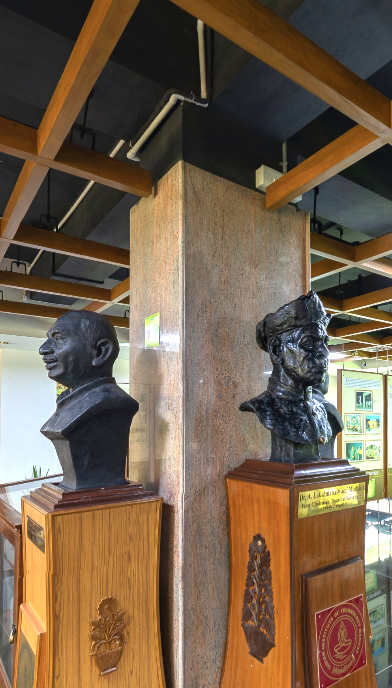Dr. Malcom S. Adiseshiah (Former Director-General of the UNESCO) gives away a degree at the 9th Convocation ceremony that was held on 26th August, 1972
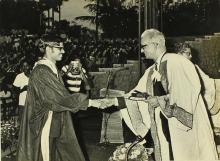
- Photographs
Dr. Malcom S. Adiseshiah (Former Director-General of the UNESCO) gives away a degree at the 9th Convocation ceremony that was held on 26th August, 1972
A student receives an award from Mr. H. V. R. Iengar
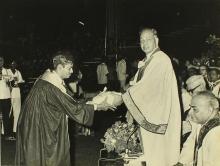
- Photographs , Administrators, Faculty, Institute Events , 1960s
Seen standing to the right of the image is Mr. H. V. R. Iengar (Chairman, Board of Governors). The gentleman seated behind the Chairman wearing spectacles is the chief guest, Dr. S. Bhagavantam (Scientific Advisor to the Ministry of Defence, India). During the convocation ceremony, apart from the conferment of degrees, it was customary for the Institute to bestow a few special prizes on a select few students. The prizes are: President’s Prize (for the B. Tech. degree student who held the best academic record), Governor’s Prize (for all-round proficiency in the B. Tech. degree course),…
A student receives an award from Mr. H. V. R. Iengar
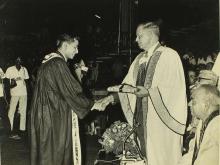
- Photographs , Administrators, Faculty, Institute Events , 1960s
Seen standing to the right of the image is Mr. H. V. R. Iengar (Chairman, Board of Governors). The gentleman seated behind the Chairman wearing spectacles is the chief guest, Dr. S. Bhagavantam (Scientific Advisor to the Ministry of Defence, India). During the convocation ceremony, apart from the conferment of degrees, it was customary for the Institute to bestow a few special prizes on a select few students. The prizes are: President’s Prize (for the B. Tech. degree student who held the best academic record), Governor’s Prize (for all-round proficiency in the B. Tech. degree course),…
A student is presented by the head of his department for the passing of Grace
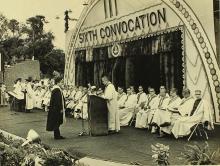
- Photographs , Administrators, Faculty, Institute Events , 1960s
At the sixth convocation a total of a total of 470 degrees and diplomas (321 B. Tech., 76 M. Tech., 30 M. Sc., 19 Ph. D. and 24 D. I. I. T.) were granted. The event commenced with an invocation, and the ceremony was declared open by Mr. H. V. R. Iengar (sixth Governor of the Reserve bank of India), the Chairman of the Board of Governors. This was followed by the department-wise ‘passing of Grace’. The head of each department respectively supplicates ‘Doth it please you that this Grace be passed’ to the members of the Board of Governors and Senate. After each member of the Board of Governors…
The distinguished guests in conversation (after the convocation)
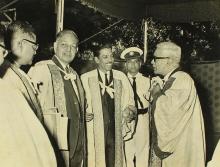
- Photographs , Administrators, Faculty, Institute Events , 1960s
Seen in the image from left: Prof. S. Sampath (Deputy Director), Mr. H. V. R. Iengar (Chairman Board of Governors), Dr. A. Ramachandran (Director, IITM) and Dr. S. Bhagavantam (Scientific Advisor to the Ministry of Defence, India). Seen behind is Mr. T. N. Venkataraman (Chief Security Officer). The chief guest and speaker at IIT Madras’ sixth convocation was Dr. S. Bhagavantam, Scientific Advisor to the Ministry of Defence, Government of India. Mr. H. V. R. Iengar (Padma Vibhushan), the sixth Governor of the Reserve bank of India and the Chairman of the Board of Governors (IIT Madras),…
Dr. S. Bhagavantam delivers his address at the sixth convocation
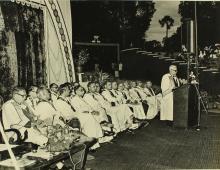
- Photographs , Administrators, Faculty, Institute Events , 1960s
Dr. Suri Bhagavantam (1909-1989), the well-known visionary scientist, administrator and architect of defense research was the chief guest at IIT Madras’s sixth convocation.Dr. S. Bhagavantam was born in Agiripalli, a village in Andhra Pradesh. He completed his primary education in Gudivada and acquired a Bachelor of Science in physics from Nizam College, Hyderabad. He joined Dr. C. V. Raman in Calcutta in the year 1928. After his Nobel Prize winning discovery, Raman chose Bhagavantam as collaborator to further his research work. During this time Dr. S. Bhagavantam got his master’s degree in…
A student (possibly) receives an award from Mr. H. V. R. Iengar
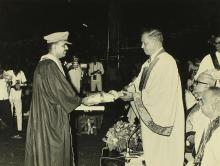
- Photographs , Administrators, Faculty, Institute Events , 1960s
Seen standing to the right of the image is Mr. H. V. R. Iengar (Chairman, Board of Governors). The gentleman seated behind the Chairman wearing spectacles is the chief guest, Dr. S. Bhagavantam (Scientific Advisor to the Ministry of Defence, India). During the convocation ceremony, apart from the conferment of degrees, it was customary for the Institute to bestow a few special prizes on a select few students. The prizes are: President’s Prize (for the B. Tech. degree student who held the best academic record), Governor’s Prize (for all-round proficiency in the B. Tech. degree course),…
Dr. S. Bhagavantam delivers his address at the sixth convocation
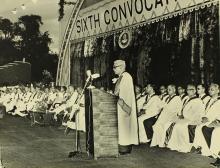
- Photographs , Administrators, Faculty, Institute Events , 1960s
Dr. Suri Bhagavantam (1909-1989), the well-known visionary scientist, administrator and architect of defense research was the chief guest at IIT Madras’s sixth convocation.Dr. S. Bhagavantam was born in Agiripalli, a village in Andhra Pradesh. He completed his primary education in Gudivada and acquired a Bachelor of Science in physics from Nizam College, Hyderabad. He joined Dr. C. V. Raman in Calcutta in the year 1928. After his Nobel Prize winning discovery, Raman chose Bhagavantam as collaborator to further his research work. During this time Dr. S. Bhagavantam got his master’s degree in…
Mr. Joshy Paul Kallungal receives the Governor’s Prize from Mr. H. V. R. Iengar
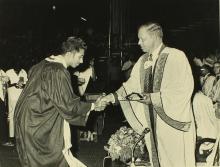
- Photographs , Administrators, Faculty, Institute Events , 1960s
Seen in the image from the left: Mr. Joshy Paul Kallungal (Governor’s Prize winner) and Mr. H. V. R. Iengar (Chairman, Board of Governors). The gentleman seated behind the Chairman wearing spectacles is the chief guest, Dr. S. Bhagavantam (Scientific Advisor to the Ministry of Defence, India). Mr. Joshy Paul Kallungal (5 year B. Tech. in Chemical Engineering) won the Governor’s prize (awarded for all-round proficiency in the B. Tech. degree course) in the year 1969. He was well loved by all, including the students of the Central School, during his time at the Institute. He joined IIT…
Prof. A. Ramachandran confers a Ph. D. to a student
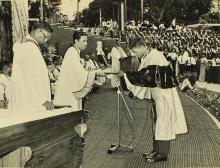
- Photographs , Administrators, Faculty, Institute Events , 1960s
Seen in the image from the left: Mr. Rajagopalan (Deputy Registrar) and Prof. A. Ramachandran (Director). At the sixth convocation a total of 470 degrees and diplomas (321 B. Tech., 76 M. Tech., 30 M. Sc., 19 Ph. D. and 24 D. I. I. T.) were granted. The Director of the Institite, Dr. A. Ramachandran, handed over the degrees to the students. During the convocation ceremony, apart from the conferment of degrees, it was customary for the Institute to bestow a few special prizes on a select few students. The prizes were handed over to the students by Mr. H. V. R. Iengar (sixth Governor of…
A filament winding machine developed at the FRP Research Centre
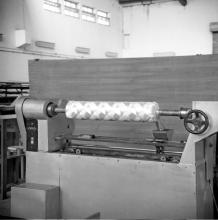
- Photographs , Equipment , 1970s
Polar winding or filament winding is a fabrication technique that is mainly used for manufacturing open (cylinders) or closed end structures (pressure vessels or tanks). This process involves winding filaments under tension over a rotating mandrel. The Composite Structures (FRP) Research Centre, also known as the Fibre Reinforced Plastics (FRP) Centre was started at IIT Madras in March 1974. It was started due to the increased use of FRP, on a global scale, for advanced technology applications as well as for commercial and domestic applications. Prior to the formation of the Centre, in…
FRP specimens under test at the FRP Centre
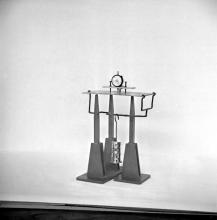
- Photographs , Equipment , 1970s
IIT Madras set up six centres in the year 1973. The Composite Structures (FRP) Research Centre, also known as the Fibre Reinforced Plastics (FRP) Centre, was one of them. The other centres that were started that year were the Regional Sophisticated Instrumentation Centre, Centre for Energy Research, Materials Sciences Research Centre, Design Engineering Centre and the Industrial Consultancy Centre. The Centre was officially opened in March 1974 and it aimed at coordinating and utilising its expertise and resources to advance the special areas of technology that were of national importance. It…
A filament winding machine
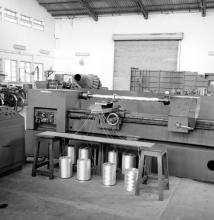
- Photographs , Equipment , 1970s
Filament winding is a fabrication technique that is mainly used for manufacturing open (cylinders) or closed end structures (pressure vessels or tanks). This process involves winding filaments under tension over a rotating mandrel. The Composite Structures (FRP) Research Centre, also known as the Fibre Reinforced Plastics (FRP) Centre was started at IIT Madras in March 1974. It was started due to the increased use of FRP, on a global scale, for advanced technology applications as well as for commercial and domestic applications. Prior to the formation of the Centre, in 1960, research and…
A filament winding machine developed at the FRP Research Centre
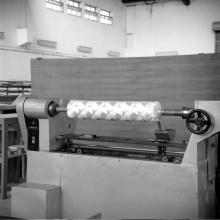
- Photographs , Equipment , 1970s
Filament winding is a fabrication technique that is mainly used for manufacturing open (cylinders) or closed end structures (pressure vessels or tanks). This process involves winding filaments under tension over a rotating mandrel. The Composite Structures (FRP) Research Centre, also known as the Fibre Reinforced Plastics (FRP) Centre was started at IIT Madras in March 1974. It was started due to the increased use of FRP, on a global scale, for advanced technology applications as well as for commercial and domestic applications. Prior to the formation of the Centre, in 1960, research and…
A plaster of paris mould for an FRP microwave antenna of diameter 1.2 meters (probably) made at the FRP Centre
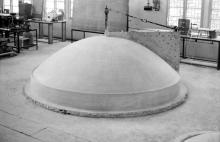
- Photographs , Equipment , 1970s
The Composite Structures (FRP) Research Centre, also known as the Fibre Reinforced Plastics (FRP) Centre was started at IIT Madras in March 1974. It was started due to the increased use of FRP, on a global scale, for advanced technology applications as well as for commercial and domestic applications. Prior to the formation of the Centre, in 1960, research and development activities in this area were initiated by the Department of Aeronautical Engineering (IIT Madras) because of the possible and increasing applications of FRP in the Aerospace field in India. In 1971, Prof. K. A. V. Pandalai…
- Contribute
to the Centre -
Monetary
Support - Digital
Material

